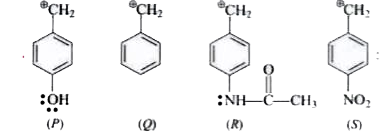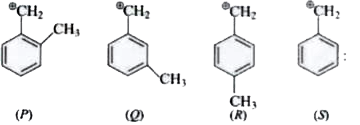The ionic conductance of the following cations in a given concentration is in the order
The correct Answer is:A
To determine the order of ionic conductance of the given cations, we need to analyze how the size of the cations affects their conductance in solution. Here’s a step-by-step solution:
Step 1: Understand Ionic Conductance
Ionic conductance refers to the ability of ions to move through a solution, which is influenced by their size and the extent of solvation. Smaller ions tend to be more solvated, which can hinder their movement, while larger ions are less solvated and can move more freely.
Hint: Remember that smaller ions are generally more solvated, which can decrease their mobility.
Step 2: Analyze the Cations
The cations we are considering are Li⁺, Na⁺, K⁺, Rb⁺, and Cs⁺. As we move down the group in the periodic table, the size of these cations increases.
Hint: Look at the periodic trends; as you go down a group, atomic size increases.
Step 3: Relate Size to Solvation
As the size of the cations increases (from Li⁺ to Cs⁺), the extent of solvation decreases. This means that larger cations will experience less hindrance in their movement through the solution, leading to higher ionic conductance.
Hint: Consider how solvation affects the mobility of ions; less solvation means higher conductance.
Step 4: Order the Cations by Size
The order of the cations based on their size (and thus their ionic conductance) is:
- Li⁺ < Na⁺ < K⁺ < Rb⁺ < Cs⁺
Hint: Use the periodic table to visualize the trend in size of the cations.
Step 5: Determine the Conductance Order
Given that larger cations have higher ionic conductance due to decreased solvation, we can conclude the order of ionic conductance for the cations in the question is:
- Li⁺ < Na⁺ < K⁺ < Rb⁺ < Cs⁺
Hint: Remember that the order of conductance is the opposite of the order of size.
Final Answer
The order of ionic conductance of the cations is:
- Li⁺ < Na⁺ < K⁺ < Rb⁺ < Cs⁺
This means that as we move from Li⁺ to Cs⁺, the ionic conductance increases.
Ionic conductance refers to the ability of ions to move through a solution, which is influenced by their size and the extent of solvation. Smaller ions tend to be more solvated, which can hinder their movement, while larger ions are less solvated and can move more freely.
The cations we are considering are Li⁺, Na⁺, K⁺, Rb⁺, and Cs⁺. As we move down the group in the periodic table, the size of these cations increases.
As the size of the cations increases (from Li⁺ to Cs⁺), the extent of solvation decreases. This means that larger cations will experience less hindrance in their movement through the solution, leading to higher ionic conductance.
The order of the cations based on their size (and thus their ionic conductance) is:
- Li⁺ < Na⁺ < K⁺ < Rb⁺ < Cs⁺
Given that larger cations have higher ionic conductance due to decreased solvation, we can conclude the order of ionic conductance for the cations in the question is:
- Li⁺ < Na⁺ < K⁺ < Rb⁺ < Cs⁺
The order of ionic conductance of the cations is:
- Li⁺ < Na⁺ < K⁺ < Rb⁺ < Cs⁺
Similar Questions
Knowledge Check
- Question 1 - Select One
The decreasing order of stability of following cations is
 AP>Q>R>SBQ>S>R>PCQ>P>S>RDQ>P>R>S
AP>Q>R>SBQ>S>R>PCQ>P>S>RDQ>P>R>S - Question 2 - Select One
The decreasing order of stability of following cations is
 AP>R>Q>SBQ>R>S>PCR>S>Q>PDP>R>S>Q
AP>R>Q>SBQ>R>S>PCR>S>Q>PDP>R>S>Q - Question 3 - Select One
The decreasing order of stability of following cations is
 AQ>R>P>SBS>Q>R>PCS>R>P>QDR>P>Q>S
AQ>R>P>SBS>Q>R>PCS>R>P>QDR>P>Q>S
The precipitation occurs if ionic concentration is
View SolutionIonic conductances of hydrated M+ ions are in the order-
View SolutionWhich of the following order of atomic/ionic radius is not correct?
View SolutionThe decreasing order of stability of following cations is
 View Solution
View SolutionThe decreasing order of stability of following cations is
 View Solution
View Solution

